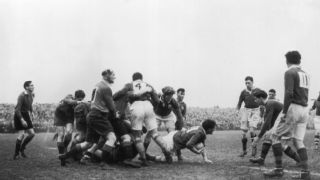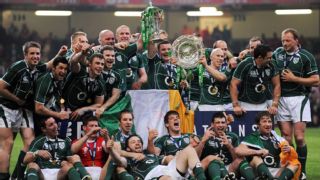|
Ireland will go for their third Grand Slam at Twickenham on Saturday, 70 years to the week since they won their first. It was completed on March 13, 1948 at Ravenhill Road, Belfast with a victory over Wales, so often in the past - an era when fixtures followed a settled pattern, and the Welsh were routinely Ireland's last opponent -- the thwarter of Irish hopes and dreams. Yet talk was of the Triple Crown, not the Grand Slam. That term, drawn from bridge, would not enter rugby's vocabulary until 1957. France, who had only returned to the competition after 16 years of exile the season before, were still not taken very seriously. The assumption that any Triple Crown winner would also be good enough to beat the French would hold good until 1949, when Ireland went down to France before beating the other home nations for the second year running. But Ireland had had a long enough wait for a Triple Crown. Their previous two had been won in 1894 and 1899. Only once since the admission of the French had they gone into their final match with hopes of a slam, at Swansea in 1926. There a late drop goal attempt by Tom Hewitt swung just wide of the posts to leave them losers by 11-8, close enough that the four points then given for a drop would have given them victory, Triple Crown and Grand Slam. Nor was there any great expectation before the 1948 Five Nations started. While they had hammered England 22-0 at Lansdowne Road in 1947, a performance suggestive of champions, defeats by France and Wales had lodged them in mid-table. And they had been dire in December 1947 against the touring Australians, going down 16-3 at Lansdowne Road. Five of that team were dropped for the tournament opener against France in Paris on New Year's Day, a Thursday. Ireland set off from Dublin on the Monday, spent two days travelling and passed Wednesday evening at the Folies Bergere, although outside-half Jack Kyle has recalled that all were in bed before midnight. That might not seem ideal preparation for an international match, but it clearly worked for Ireland who won 13-6. The selectors could feel particularly pleased with themselves, since two of their tries came from debutants -- centre Paddy Reid and flanker Jim McCarthy -- and the third from goal-kicking winger Barney Mullan, who had been omitted against the Australians in spite of scoring three tries during the 1947 Five Nations. McCarthy in particular had brought a fresh dimension to the team, complementing the relentless tackling of Bill McKay as, Ned van Esbeck has recalled, "an opportunist who brought a new concept to wing forward play and was to prove the principal agent of Kyle's plan for breaching the opposing cover." Nor did Ireland's selectors believe theories about not changing a winning team. There were five more changes for the following match, six weeks later at Twickenham. Among them was the axing of scrum-half and captain Ernie Strathdee, whose position went to Hugh de Lacy of Harlequins while the leadership was inherited by hooker Karl Mullen, 21. Like Kyle a medical student, Mullen was Ireland's fourth leader in six Five Nations matches since the war. Already a fine hooker, he showed himself to be an inspired leader. As Terry Godwin later wrote, he welded a "fiery gang of forwards into a formidable unit who hunted together and supported each other with a discipline and dedication which was to characterise Irish rugby hereafter."  Ireland won 11-10 at Twickenham, a scoreline which understated their superiority. Veteran journalist Dai Gent hailed "a great Irish side and a great victory." They scored three tries through Kyle, McKay and centre Des McKee, but Mullan converted only one of them. They appeared to be cruising at 11-5 late in the game, with a kickable penalty to come. But Mullan's effort clanged off the post and within seconds English wing Dickie Guest, a rare survivor from prewar Tests, had intercepted a Kyle pass to run 60 yards for a his second try of the match, which was converted to cut the gap to a point. Kyle recalled that he "did not enjoy the last 10 to 15 minutes." It was at this point, Mullen later recalled, that the possibilities of the season began to dawn. With two away wins secured, home victories over Scotland and Wales would give Ireland their best ever season. Scotland were seen off first 6-0 at Lansdowne Road, with tries from Kyle -- increasingly acknowledged as the presiding genius among an otherwise fairly workaday back division -- and Mullan. But neither was converted, in keeping with a season in which Ireland would score 10 tries but only convert three of them and fail to land a single penalty goal. Kyle had enjoyed playing outside De Lacy, whom he recalled as "a lovely passer," scoring in both matches. But out went the young Munsterman, never to return, as Strathdee -- his greater power felt necessary as a counter to the Welsh forwards -- was recalled for the decider. Mullan recalled to van Esbeck that "We were tense and nervous, but I knew, and the players knew, we could win." The nerves focused on a Welsh back division featuring scrum-half and captain Haydn Tanner, centre Bleddyn Williams and wing Ken Jones. Ravenhill, the venue for every Ireland v Wales match between 1927 and 1952, was packed to its 30,000 capacity and could have been sold out several times over. Reid, recalled after being left out of the Scotland game, remembered that "The atmosphere was electric. Our preparations were very thorough, every man was given a job to do." Those preparations included a pre-match meeting in which Mullen insisted as a matter of principle that every team member should be encouraged to contribute. Its conclusion was clear, that the tactic of playing the game through the forwards -- generating copious quantities of what would later be known as second-phase ball -- and Kyle which had served them so well so far should be maintained. They started well. Mullen was reassured when a kick sailed just over Wales fullback Frank Trott's shoulder and rolled into touch close to the Welsh line -- just the sort of luck, he felt, that pointed to a good day. And Ireland struck first, with a long Kyle pass, missing out his centres, hitting Mullan at full tilt. The wing sped away for his third try of the season. But Wales hit back with a fine solo score from Bleddyn Williams and it was 3-3 at half-time. Mullen recalled that "The 'council of war' we held at the interval gave us a lift and we were, I believe, the better team in the second half." The crucial moment came early in the half as prop Jack Daly, remembered by wing Bertie O'Hanlon as "The iron man of the team. No man could bend him," lived up to the "Playfair" annual's description of him as "a fine all-round forward," by seizing the ball from a lineout close to the Welsh line and diving over. From then on Ireland played, Mullen remembered, "like men possessed." Wales' formidable attackers were boxed in, the Irish pack kept control and Kyle worked the touchlines. As the game went on Mullen felt that "we had only to avoid doing something rash." Daly, more colourfully, is reported as reckoning that he would be "f------ canonised" if Ireland held on. And that they did, winning 6-3. The crowd rushed the field and Daly's shirt was ripped to shreds by souvenir hunters as he was carried off shoulder-high. It was not, van Esbeck recalled "Vintage rugby, but it was a champagne occasion, a long-cherished dream realised. It was a just reward for effort and ability, for determination and character." It was not greeted with total enthusiasm elsewhere. The venerable Welsh writer Townsend Collins felt that "Ireland touched greatness, but it was not all-round greatness," pointing to the limitations of their threequarters. "Playfair" credited the excellence of Kyle, Daly and the wings, but thought the centres 'noticeably poor', a charge which Mullen rejected, pointing to the excellence of their defence against Wales.  Some critics noted that while the other four nations had been at war until three years earlier -- and France under occupation -- Ireland had been neutral. Comedian Dave Allen was unimpressed when confronted with this line of reasoning after Ireland beat England in 1949, expressing incredulity that that the others could "beat the crap out of the German army, but not 15 Irishmen." Four of the Irish 15, including both try-scorers, played their last international that day at Ravenhill. Daly and Reid both went to rugby league with Huddersfield that summer and enjoyed such distinguished 13-a-side careers that in 2004 they were among the first six players admitted to Rugby League Ireland's Hall of Fame. Mullan's Test career ended with six tries in eight matches, Five Nations leading scorer jointly with Jean Lassegue of France in 1947 and outright in 1948, suggesting that he may have been a little more than the "not the greatest player, but a great man in a sing-song" fondly recalled by Jim McCarthy 60 years later. Fullback Dudley Higgins gave way in 1949 to George Norton, who solved Ireland's goal-kicking worries. The rest went on to build Irish rugby's greatest era until the modern age of O'Driscoll, O'Connell, Kearney, Sexton and Best. There was another title and Triple Crown in 1949 and a further championship, thwarted of Triple Crown and Slam only by a draw with Wales, in 1951. In between those two campaigns Mullen led a fondly-remembered Lions team with a strong Irish contingent, and Kyle acknowledged as perhaps the finest outside-half ever seen in those parts, to New Zealand and Australia. Their fame inevitably grew as their achievement became more distant, but remained unique. The survivors paraded on the 50th anniversary of the feat, before the Wales match at Lansdowne Road in 1998. In the present century advancing age inevitably took its toll. Karl Mullen lived just long enough to see Ireland's second Slam in 2009, dying a few weeks later after the match at Cardiff. Kyle and Bleddyn Williams were both there - Bleddyn characteristically evoking his memories of 1948, but failing to mention his brilliant try. The last survivors, Reid and O'Hanlon, died in 2016. But their memory will be cherished this week as their compatriots seek to emulate them at Twickenham.
|

